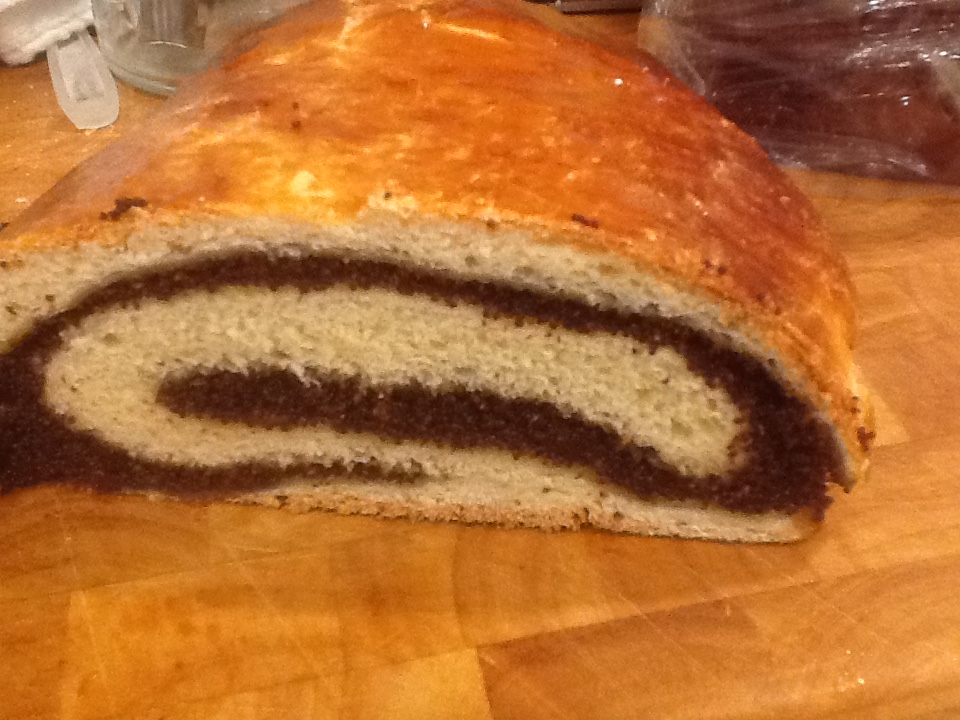That looks wonderful and sounds really good, could you point me toward a recipie please?
OK, here's the pumpkin challah. This is my normal challah with added pumpkin. If you leave out the pumpkin, add less flour while kneading. Or you could add more pumpkin and a little more flour.
I have divided the ingredients so it makes sense in the steps:
1 TB sugar
1 cup water
3 TB yeast (or 2 packets)
30 ounces bread flour (plus more for adjusting)
1 TB salt
1/3 cup of sugar
2 eggs (plus one for egg wash)
1/3 cup oil
1/2 cup canned pumpkin
Dissolve 1 TB sugar in a cup of warm water. Add yeast and let it proof for 10 minutes.
Mix eggs, oil, pumpkin, and yeast slurry in the bowl of a stand mixer until well combined.
Add dry ingredients and mix/knead with the dough hook until it is smooth and elastic. It will be tacky, but not stick to your hands or the bowl. If it's too dry, add a TB water OR a little oil. If it's sticky, add flour a TB at a time. Try to avoid adding too much flour - sometimes it just needs to keep kneading and it gets right.
Knead for 5-7 minutes. (I sometimes crank it up to 4.)
Form the dough into a ball and put it in an oiled bowl, turning to coat the whole thing.
Cover with foil or plastic wrap and let it rise in a warm place until doubled in size (60 to 90 minutes).
Punch the dough down and divide it in half or fourths (depends on the size of loaf you want).
You can shape it a lot of ways, including braiding 3 strands or simply rolling it into a spiral. Or braid 3 strands and role that into a spiral. Tuck any loose ends under the loaf and pinch together.
My cheater braid is to roll it into a rope about 25-30 inches long. Pick the rope up in the middle and twist the ends together, forming a loop at your hand where you're holding it. Then pull the twisted ends through the loop and tuck the tips under the loaf. Push it all together gently to form a tight oval.
PREHEAT THE OVEN to 350 degrees.
Put your loaves on a sheet pan lined with parchment.
Brush with egg wash (1 egg plus 1-2 TB water) and cover loosely with a tea towel or plastic wrap.
Let the loaves rise 30 minutes. I don't get a lot of rise on this second time, but that's ok, it will poof up in the oven.
Brush with egg wash again, working it into the crevices. Sprinkle with 2 TB pepitas (or sesame, poppy, or nearly any other seed). If the pepitas are not super salty, a sprinkle of kosher or sea salt is good, too.
If you want more pumpkin *spice* flavor, you could sprinkle with a tiny bit of nutmeg, cinnamon, allspice, or "pumpkin pie spice." You can also sprinkle with brown sugar. Go easy on any of these, though.
Bake for 30-40 minutes until the loaves sound hollow when you tap them. (200-205 is a good internal temp.) If they start to get too brown, cover with foil. Cool on a rack.


























![Craft A Brew - Safale S-04 Dry Yeast - Fermentis - English Ale Dry Yeast - For English and American Ales and Hard Apple Ciders - Ingredients for Home Brewing - Beer Making Supplies - [1 Pack]](https://m.media-amazon.com/images/I/41fVGNh6JfL._SL500_.jpg)



































